It seems every time I write another entry in the Traffic Soyboys series I have to preface it with saying “I know I haven’t updated this series enough, but I promise I’m blitzing towards the finish.” And then I have to explain why I haven’t actually finished the series yet, or even made progress. The last entry in the series was a full ten days ago, and I promised to be finished by March.
The problem is that we’ve reached the point in the series where the Urbanites are supposed to be providing evidence for their claims. Strong Towns is the intellectual underpinning behind the YouTube e-revolutionaries claims about Induced Demand, Suburban Ponzi Schemes, and the like. But Charles Marohn, the creator of Strong Towns, is a pretentious moron whose entire argumentation style is extreme non-sequiturs that don’t even prove what he claims they prove, or in some cases even prove the opposite. In between non-proofs, he writes ten thousand words of conjecture.
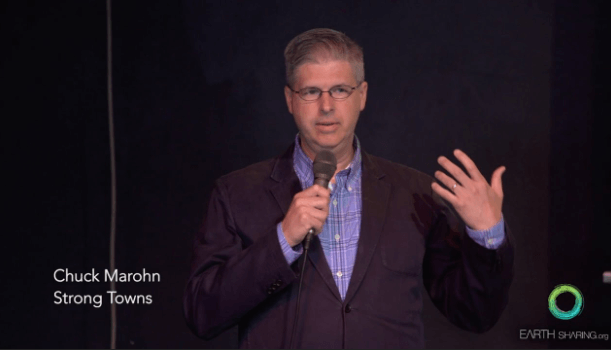
The original political purpose of this series was to show that these people are full of shit and malicious, and I feel that I have already accomplished this many times over. Do we need another example of Jason “NotJustKikes” Slaughter saying easily debunked nonsense, such as Cadillac Escalades ackshually having less interior space than Subaru Outbacks? Sure, but this eventually hits diminishing marginal returns, and I have other things to work on and write about without this series hanging over my head. Besides, I have a very important personal project that has taken up much of my time.
I’ve said that I was going to blitz through the rest of the series, but now I mean it. Expect these pieces to be much shorter than the previous ones, since I don’t feel the need to autistically document every last little tidbit of nonsense that these cretins bloviate about. I think at this point you’ll just have to take my word for it that I’m not taking anything out of context. It really is that stupid. You can always follow the links to read this empty nothing for yourself.
Strong Towns Growth Ponzi Scheme Part 3:
A new development goes in. The developer builds the street and then turns it over to the city for maintenance. Houses are built and the city sees its property tax receipts rise. Imagine for a moment that the city took and saved the portion of those new receipts that was to be used for street maintenance. If the city did that every year throughout the life of the street, adding the new tax receipts to those already saved, and then used the cumulative savings to repair the street, here is how the cash flow diagram would look.

In the third installment of his series holocausting the suburbs – and small towns to boot – Marohn gives us a series of graphs. The first is his theoretical net cumulative cash flow for Ponzi Scheme development. The argument is that the infrastructure necessary to support a new development is subsidized, or maybe paid for by the private developer.
In his own example from the previous entry he showed that it was paid for by the town itself, and they lost money on this right up front. That showed the opposite of what he was claiming, which is that municipalities make money through property taxes up front, then eventually lose money when they need to pay for maintenance on said properties.
Nevertheless, even if his one example had actually proven his point, instead of the exact opposite, this is all still speculative theorizing that he’s doing here. He doesn’t have access to any municipalities real budget. Instead, he has his unchecked hypothesis, that he assumes to be true.
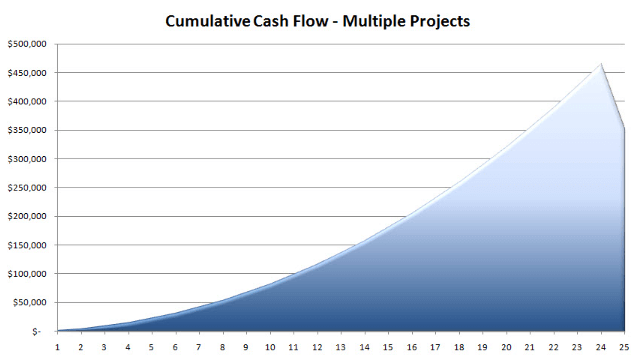
The speculation continues. Here he has created a graph with lots of theoretical development projects staggered out through time. He hypothesizes that the municipality makes lots of money early on through property taxes, but then progressively starts to lose money as the maintenance costs rise. Finally, the hypothetical fantasyland graphs end with this one, showing that the poor suburb/small town has utterly holocausted its finances with these hard to maintain roads or something.

Yes, this is all theoretical. It’s also easily debunked by doing what I did in the last piece, and looking at the population sizes of the small towns that are supposedly Ponzi schemes. Since they aren’t growing, and in fact may be declining, clearly the towns are not sustaining themselves on some ever increasing expansion, since they aren’t expanding at all.
That’s really all there is to say about this. He conjures up a wild hypothesis that suburbs and small towns are all secretly Ponzi schemes. He uses real life examples that don’t come close to proving what he says they prove, or even show the opposite. Then he shows that, if his ludicrous premise is true, these municipalities should all be going bankrupt after about 20 years. At no point in this piece or the next does he address the very obvious question of how these municipalities have not already gone bankrupt, since this Ponzi scheme is apparently about eighty years old at this point.
I guess it’s one of those Ponzi schemes that really can run infinitely long, and doesn’t require an expanding group of chumps at the bottom. The sustainable Ponzi scheme that is destroying our nation.
Second, this model shows the impact of continuous and steady growth. In reality, that is not the pattern most cities experience. Most cities have a phase of rapid growth followed by stagnation and then decline, as described by Jane Jacobs in The Economy of Cities. Superimpose the financial underpinnings of the American model of development and the results are even more devastating – a flood of liabilities all coming due right at the time that growth is starting to wane.
He ends by favourably referring to (((Jane Jacobs))). I covered that anti-White in the third piece in this series that went over the (((Robert Moses))) (((Jane Jacobs))) finklefight. What do you want, Goy? Would you prefer your neighbourhoods paved over and turned into soulless, cookie cutter supermarkets, or would you like homeless crack addicts of colour stabbing you as in San Francisco? Take your pick, Goy. No other options available.

Small Towns Ponzi Schemes Part 4:
The great American experiment in suburban development entices communities to take on long-term liabilities in exchange for near-term cash advantages (see Part 1). But as those liabilities cost the community more than the development creates in overall wealth, the approach ultimately results in insolvency (see Part 2). To forestall the day of reckoning, more growth is induced, setting up a Ponzi scheme scenario where revenue from new development is used to pay liabilities associated with old development (see Part 3). This is unsustainable, but that has not kept us from trying desperately to keep it all going.
Much of my thinking in this post was shaped by my reading of Richard Florida’s The Great Reset, as well as follow-up research I have done into the causes of the Long Depression of the 1870’s and the Great Depression of the 1930’s.
The Great Reset?

A coincidence. This piece is twelve years old. Anyway, he goes on a long rant about the history of the Great Depression, and what he calls the “Long Depression of the 1870’s.” There is one interesting moment where he has this to say.
While these events defy simple explanation, the Long Depression included an over-development of the nation’s railroad system and a corresponding malinvestment in speculative real estate associated with railroad expansion. Also, the increased access for farmers to broader markets helped create a commodity price crash, which was exacerbated by overproduction. Farmers with declining profits produced more to compensate, driving down prices. Price drops were so dramatic that some crops became more valuable for burning than eating.
Shhhhh, Chuck. Don’t let the trainfags here you say that. Next thing you’ll be telling us that California’s $100+ billion train to nowhere isn’t a swell investment.
Look, there’s no such thing as over-investing in transportation infrastructure, because people have infinite demand for transportation, according to the Traffic Troons. That’s why we can spend arbitrary amount of societies resources building trains to nowhere. It’s just the smart thing to do.

Although trucks very bad and unsustainable because reasons. Car infrastructure something something deletes itself. This only works for trains and buses. You’re too dumb to understand why.
This strategy is a disaster of monumental proportions for the United States. Not only have we created an entire economy based on a growth model that can’t be sustained, in the process we have highly indebted our population. The quality employment opportunities available for the masses rely solely on the perpetuation of this unsustainable model, so we can’t even work our way out of this mess. We’ve tied up our individual wealth into homes — homes whose value is tied to community infrastructure that we cannot afford to maintain without continued hyper-growth, which we are now powerless to induce. So as our wealth disappears and our economy painfully grinds to a halt, we’re left with no options to continue on this path.
And to top it all off, we’ve tethered our national psyche to the suburban ideal we call the “American Dream”, our auto-based, utopia where everyone gets to live a faux version of European aristocracy on their own mini-estate.
The entire US economy is based on small towns and suburbs occasionally overdeveloping. There is no proof offered for this statement, and the source is Trust Me, Bro. Also, the problem is that you, peasant, have high standards for your quality of life, and are demanding a mini-estate. Wars for Israel aren’t a major thing bankrupting America, or endless migrants, who are objectively net tax consumers. The same is true for massive bailouts for banks, and big corporations.

No, the problem is car infrastructure, and White People in small towns and suburbs getting nice things. That’s an unsustainable Ponzi scheme.
Strong Towns Ponzi Scheme Part 5:
There is a fine line one walks when doing a series like this, and I struggle with it myself. On one side of the line, there is a tremendous problem we’ve identified, it has dramatic consequences that we are largely unaware of as a culture, and I want to yelp at the top of my lungs to make people aware. On the other side of the line is an awareness that the world does not want to listen to a sky-is-falling, doom-and-gloom, pessimist. We tend to call such people “crazy” and, in time, zone them out.
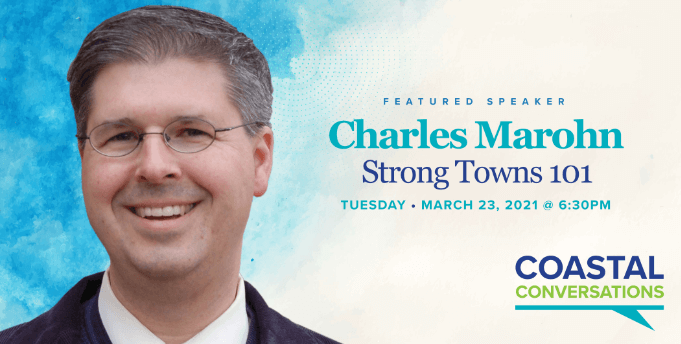
One of the reasons why people tend to call “the sky is falling” types crazy, is because they are. There are lots of systemic forces that work to keep things in equilibrium. Look at South Africa for an example of a country that has been destroyed, and yet has failed to collapse. Even if you discover some financial shenanigan that the banks or (((Blackrock))) are pulling off, unrelated to suburban Ponzi schemes I might add, there is no reason to think that they won’t simply get a multi-trillion dollar bailout funded by your taxes.
Lots of things that are financially indefensible are entirely sustainable, but even that’s besides the point. This is the last piece, and Marohn has yet to even moderately prove his point, which is that suburbs and small towns are Ponzi schemes, so much so that this is the basis of our entire national economy. Even when I was a partial LOLbertarian, I never saw Just So theorycelling of this magnitude, but Marohn, having not proven his premise in the slightest, has moved on to doing a victory lap where his Ponzi scheme premise is assumed.
I’ll spare you the details. There is no evidence offered, he just bloviates about the difficulty of overcoming the challenge of normal people thinking that he’s an annoying dipshit, so that he can be given free rein to save America from a non-existent problem. His work is 1% laughable attempts to prove his hypothesis, 49% assuming the premise and declaring that we are doomed, and 50% whining that no one takes him seriously.
But luckily, he has a solution.
America is in a slow-motion car wreck. Lots of people are being hurt by it, some very badly. We’ve long lost our insurance by accumulating so much debt. We’ve also relinquished our production capacity. And we have little savings to speak of. What’s the solution?

Yes please, Mr. Marohn. My body is ready. Enlighten us all.
I wish I had one. I really do. I would be a very popular person, indeed. Unfortunately, all I can offer are rational and irrational responses.

You’d think that very simple changes to the tax code, or some small regulations here or there would fix the problem, but Marohn’s Suburban Ponzi Scheme claim is so fake that he can’t even propose rational solutions. I’m not sure if he’s clever enough to avoid going on record advocating for something specific, or if he’s just a complete and utter moron who never realized that if people are doing x, you can just make x illegal and it stops.
To be clear, if it were true that the entire country of the USA was going bankrupt because greedy, shortsighted municipalities were allowing developers to make profits by developing land, because something something property taxes now maintenance later, it would be trivial coming up with legislation to stop this. This is really not a problem where you need to throw your hands up in the air, bereft of a solution. This is a very solvable problem. It’s just also not actually real.
At Strong Towns we are trying to explain our current financial crisis — and the transition in our living arrangement that must happen — in a way that local officials can understand and discuss in their own communities. We are also working hard to develop the tools that are needed to help our cities, towns and neighborhoods make this difficult transition. If you value what you have read here this week and would like to help us promote the Strong Towns message, consider supporting us with a one-time or a recurring donation.
The real solution is to PayPal him. That’s the proof that suburbs and small towns are Ponzi schemes, and that’s the solution. A small town subsidized a road to his house, so PayPal me.

I put off this part of the series for so long precisely because there’s nothing here. There is not even misinterpreted data, there’s just a bunch of theorizing about how maybe suburbs are Ponzi schemes because municipalities could theoretically be incentivized to prioritize short term property tax profits over very mild long term maintenance net tax consumers. Occasionally he throws in a real life example that in no way shows this to be true.
I dreaded writing about this for so long because it’s very hard to write “and he still hasn’t proven his point,” in a creative way many times in a row. It’s easy, especially with people who regularly bump up against the schizo e-right, to assume that the author is misleading the reader, so I felt I had to build up tons of credibility to the point where you accept that I’m not leading you down a blind alley, and part of that is extensive quoting of the source material from Marohn. But I can’t just quote the entirety of his nonsense, so ultimately you’ll have to trust me when I say that quoting any part of his work is as good as the rest, because he never bothers proving his premises, especially in the latter pieces. Feel free to read the pseudo-intellectualism yourself. There’s just no there there.

And that’s the reason why all the Traffic Antifas bloviation about suburban Ponzi schemes is so vague, abstract, and Just So. It’s a load of nonsense based on nothing. Luckily, they updated the Ponzi scheme work with more recent stuff, which is far more humourous. We’ll touch on some of that in the next piece, which I promise will actually be coming soon.

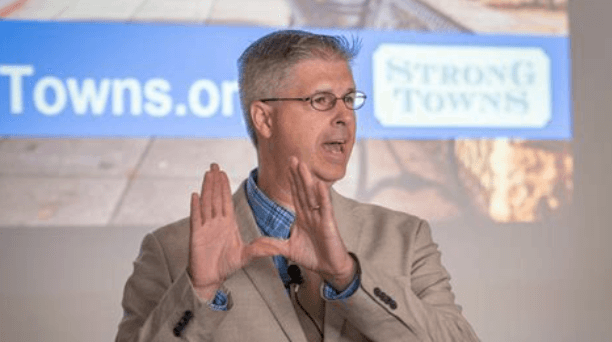









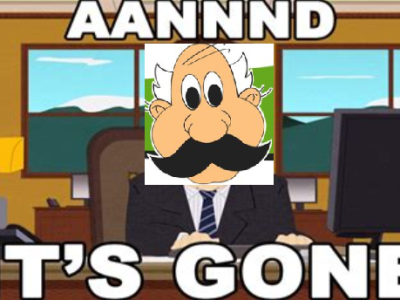
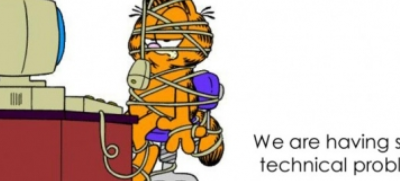

“But as those liabilities cost the community more than the development creates in overall wealth.”
It can’t be that hard to find the budget for a local municipality and test that. At least some of those must have public records. And I’m sure if what he was saying was true, municipalities would love him coming around to prove it, because it would help them beg for federal dollars that much better. The response to his articles must be always, “Show me the money!”
“I’ve made up a problem that doesn’t exist, and I don’t even have a solution. But if you give me some shekels, maybe one day I’ll figure it out. Trust me.”
This guy doesn’t look like an Israeli citizen, but he certainly has the chutzpah of one.
[…] dailyrake.ca/2023/04/10/psa-deboonking-the-traffic-soyboys-part-27-blitzing-through-the-absence-of-p… […]